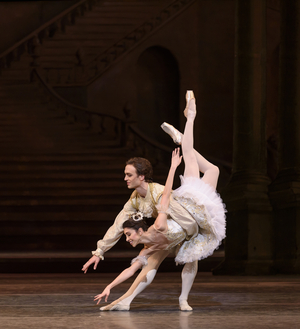Review: THE SLEEPING BEAUTY, ROH Live

![]() The Royal Opera House is on a mission to show that ballet and opera are accessible to everyone. As part of their live cinema season, last night saw Tchaikovsky's beautiful interpretation of fairytale, The Sleeping Beauty, broadcast live across the world.
The Royal Opera House is on a mission to show that ballet and opera are accessible to everyone. As part of their live cinema season, last night saw Tchaikovsky's beautiful interpretation of fairytale, The Sleeping Beauty, broadcast live across the world.
Directed for the screen by former ballet dancer Ross MacGibbon, the production translates wonderfully to the cinema. MacGibbon has vast experience in directing stage shows for broadcast and it shows. Usually, some of the nuance and exquisite detail is missed when attending the ballet, unless you are lucky enough to be seated in the front stalls. However, one of the unexpected joys of seeing this ballet at the cinema is how the production flows like a film, but it still feels very much like a stage production.
Some of the panning shots going across the stage feel a little fast at first, but that quickly settles and the audience feels they are seeing the very best of the action. There is a distinct intimacy in seeing the faces and bodies of the dancers so close up and the acting is good enough to carry off the emotion in the story.
For some, there will a sense of being told what to see; watching the activity at the side of the stage is rarely an option, but the manner in which these screenings make ballet so accessible can only be applauded. The experience is also enhanced by the interesting bonus content such as interviews with the conductor and inserts with interesting facts about the history of the production. Apparently resources were so tight after the war that the costumes were designed with paper doilies used as lace cuffs.
There are also angles you would never see if you were at the production itself, such as shots within the orchestra pit and backstage during the intervals where the cast wander around behind presenters Darcy Bussell and Anita Rani.
Choreographed by Marius Petipa in 1946, The Sleeping Beauty was the ballet that revived the ailing opera house after the war and initiated its move into showcasing world-class ballet. The story is well-known and not particularly complex. The beautiful Princess Aurora is destined to sleep for one hundred years after being cured by evil fairy Carabosse. To break the spell, Prince Florimund is led to the sleeping princess, who wakes her with the kiss of true love. Good triumphs over evil: the end.
The thrill of this production is not the story; it is a combination of the score and the incredible staging and choreography, which looks as good as it sounds.
Any dancer who takes on the role of Aurora knows they have huge pointe shoes to fill, as this was the role that the late, great Margot Fonteyn made so famous. Due to injury, First Soloist Fumi Kaneko danced the role of Princess Aurora, replacing Lauren Cuthbertson. A rising star in the company, Kaneko previously danced the role of the Lilac Fairy, but first danced Aurora back in November and rises to the technical challenges of the role, particularly in the Rose Adagio where her balance is immaculate. She moves very delicately, but with great poise and stamina in her excellent phrasing. She is also adept at showing the excited teenager on the cusp of womanhood.
The close-up shots of Kaneko are revealing; showing the thousands of tiny muscular adjustments needed for her balance and movement. It also feels as though there is a renewed appreciation of the scale of the physical effort required, when you can see the sweat on the dancers' bodies, while their faces remain composed.
Kaneko is partnered solidly by Italian Principal Federico Bonelli as Prince Florimund. Bonelli is adept at playing the romantic hero and feels very invested in the role.
The production is a showcase for the whole company and shows the multiple layers of talent in the company. First Artist Gina Storm-Jensen stepped in for Kaneko as the Lilac Fairy; she takes her time with the pirouettes and is a pleasure to watch. Her nemesis Carabosse is danced by Principal Character Artist Kristen McNally, who is a flamboyant and theatrical villain. Her mocking of the other fairies giving their gifts to the baby is wonderful.
Act III's The Princess and the Bluebird is perfectly pitched by Yasmine Naghdi and Matthew Ball. Ball is as light as a feather in his jumps, landing with total balance and confidence and his batterie is deftly defined. Naghdi matches his lightness perfectly, with beautiful poise.
Olivier Messel's opulent costumes are a visual feast; from the courtiers to the main characters, the detail and richness is quite extraordinary, enhanced by the close-up shots of the gold brocade, shimmering fabric and elaborate head pieces. The other hero of this production is, of course, Tchaikovsky's incredibly rich and varied score, conducted by Simon Heweet. Heweet brings out wonderful expression from the Orchestra of the Royal Opera House.
This is a remarkable production performed with incredible grace and elegance by the Royal Ballet. For people all over the world to able to share it is a wonderful thing.
The Royal Opera House Live Cinema Season continues throughout the year
Photo Credit: Bill Cooper
Videos

